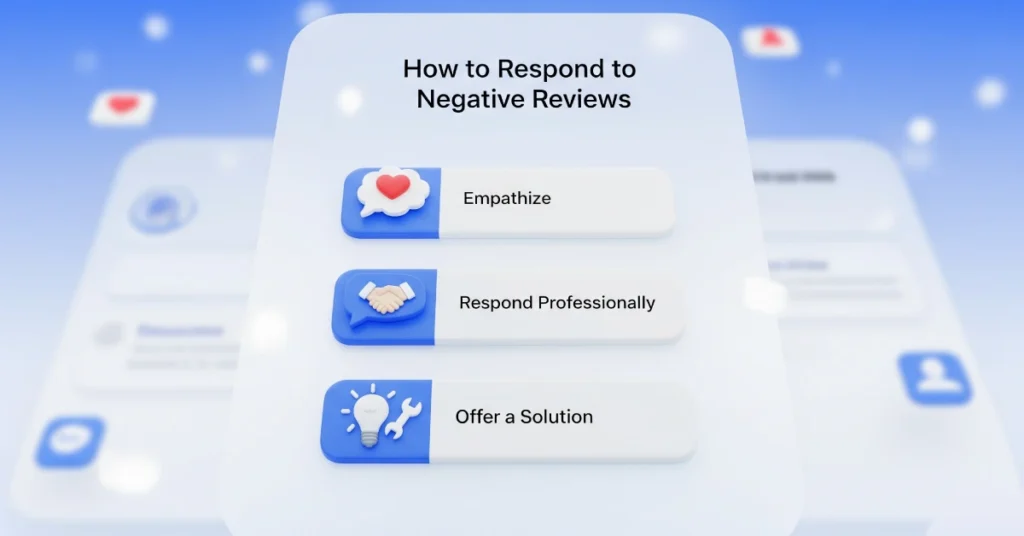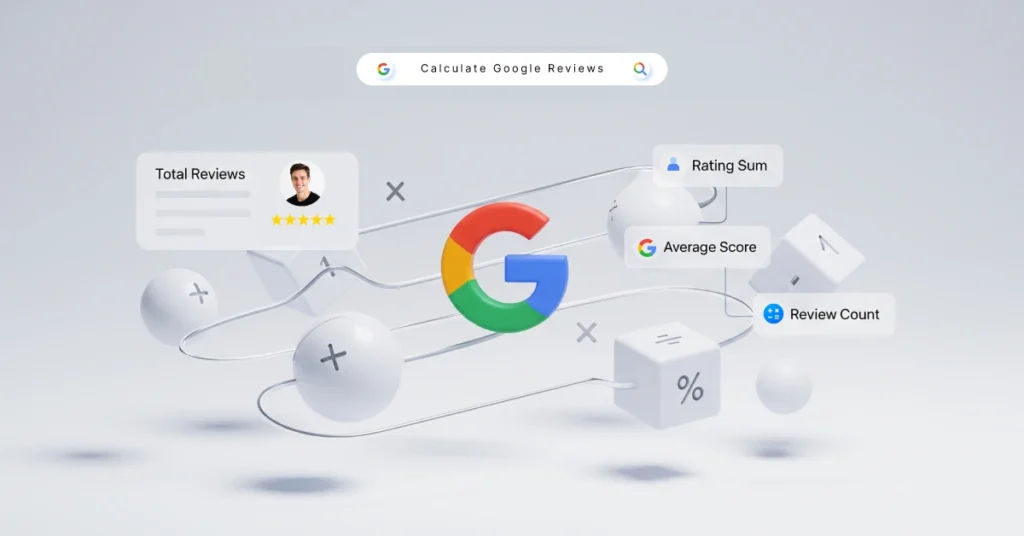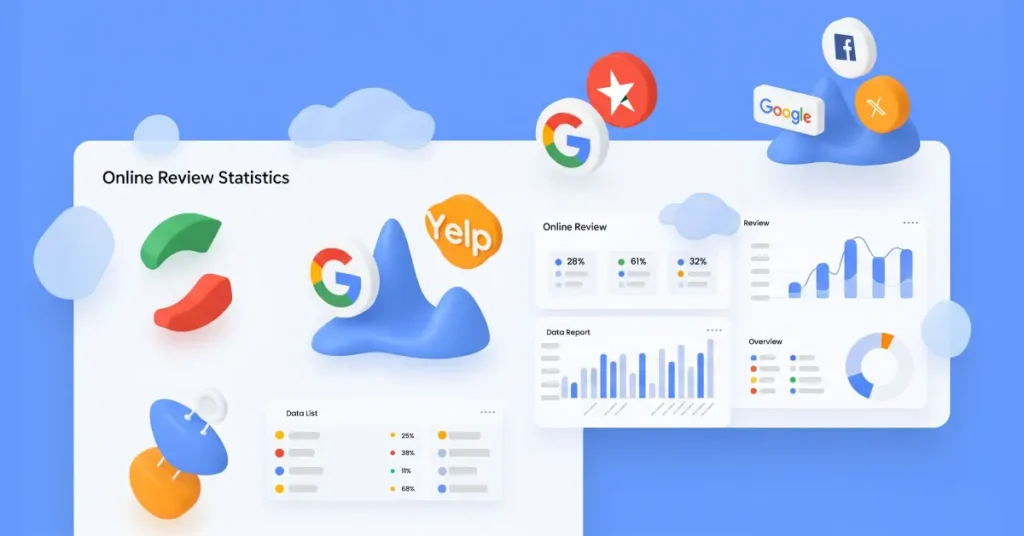I have been advising businesses on how to manage their reviews for years now. I can assure you that one of the things that stresses business owners is responding to negative reviews. Did you know that 94% of consumers say a single bad review has convinced them to avoid a business? It is a staggering figure that shows just how powerful customer feedback can be.
As a marketer, I know firsthand how a negative online review can feel like a punch in the gut. It is tempting to ignore it or lash out in defense.
However, managing online reviews is now a non-negotiable part of running a business. How you respond to negative reviews can make or break potential customers’ trust and even influence your visibility in local search results.
In this guide, I will show you how to respond to negative reviews in a professional, effective way.
Let’s get into it!
Why Responding to Negative Reviews Matters
You wouldn’t want your clients to feel like you are ignoring their concerns. Here is why replying to those negative reviews matters:
1. Customer Perception and Trust
It only takes one nasty one-star review on Google or Yelp to scare off potential customers. People place a lot of trust in what other customers say – sometimes as much as a personal recommendation.
But here is the silver lining: how you handle that bad review can actually regain trust. When future customers see you addressing issues head-on, it signals that you care about customer experience and are willing to make things right.
2. Influence on Local SEO Rankings
Online reviews are one of the key factors in local search algorithms. In fact, review signals account for roughly 15% of Google’s local ranking factors. This means businesses with better review profiles tend to rank higher in Google Maps and local pack results.
That profile isn’t just about having a high star rating; it is also about engagement. Google has explicitly encouraged business owners to reply to reviews, and doing so can slightly improve your local SEO by boosting your profile’s activity and prominence.
5-Step Proven Framework to Respond to Negative Reviews
Dealing with a bad review can be emotional, but having a clear game plan makes it much easier to respond calmly and effectively.
Over time, I have developed a 5-step framework, called the 5 A’s, to guide your response:

Step 1: Acknowledge the Issue
Start by acknowledging the customer’s experience and feelings. The worst thing you can do is sound dismissive or ignore the specific complaint. Show the reviewer that you hear them. It tells the upset customer and everyone reading that you are listening.
Even if you privately feel the complaint is exaggerated or unfair, start from a place of empathy.
Step 2: Apologize Sincerely
Offer a sincere apology for the trouble the customer experienced. A genuine “I’m sorry” goes a long way in repairing trust. The key here is sincerity, because customers can sniff out a fake or copy-paste apology in a second, which can further damage your credibility.
Step 3: Address the Specific Concerns
After saying sorry, it is time to address the specific issues raised in the review. This is where you offer context or correct any misunderstandings without making excuses. The customer took the time to detail their complaint, so respond to the details. If there is a brief, factual explanation you can provide, do it here in a professional manner.
Step 4: Act by Offering a Solution
A complaint left unaddressed is a missed opportunity; a complaint addressed with action can transform an angry customer into a loyal one. Depending on the situation, “action” can take different forms:
- Fix or Compensate: If the situation warrants, offer to make it right. Offering a refund, replacement, discount, or complimentary service in the future can show the customer you are serious about remedying their bad experience.
- Improve for the Future: Describe briefly what steps you are taking so this doesn’t happen again. This demonstrates accountability and a commitment to quality improvement.
- Invite Further Discussion (if appropriate): If the issue is complex or sensitive, invite the reviewer to discuss it offline so you can get more details and come to a resolution.
The exact action will depend on the scenario but always propose a constructive next step. Even if the customer never takes you up on it, readers will see that you tried to resolve it.
Step 5: Appreciate the Feedback
Finally, end on a positive note by thanking the customer for their feedback. Yes, even though it was negative! It may feel odd to thank someone who just bad-mouthed your business, but it is the classy and strategic thing to do.
A customer who leaves a negative review is essentially pointing out a problem, and that gives you a chance to fix it.
Negative Review Response Examples (Industry-Specific)
I have put together five scenarios across different industries. Think of these as review response templates you can draw inspiration from and tailor to your own business.
1. Restaurant: Piccola Cucina Estiatorio

2. Dental Practice: Perfect Smile – Dentist in Tulsa, OK

3. Retail Stores: Ann Summers Ltd

4. Automotive Services (Auto Repair Shop): USA Automotive

5. Salons (Personal Care Services): Lavish Hair Lounge

How to Handle Fake or Malicious Reviews
Sometimes the worst reviews your business receives aren’t from actual customers at all. In the age of online anonymity, fake or malicious reviews are a real problem. It could be a competitor trying to sabotage you, an internet troll, or someone who has mistaken your business for another.
As a local business owner, I have seen how infuriating and unfair this can be. The good news is, you don’t have to just sit and take it.
Here is how to recognize phony reviews and deal with fake negative reviews in a professional manner :-
Spotting Fake Reviews
How can you tell if a review is fake or planted by a malicious actor? There are a few common indicators of fake reviews to watch for:
- Lack of detail or specifics
- No record of the customer
- Mismatch between review and business reality
- Extreme emotion or aggressive language
- Reviewer’s profile behavior
Flagging Fake Reviews (Google & Yelp)
All major review platforms have policies against fake reviews and mechanisms to report them. The process may vary slightly, but generally it is known as “flagging” or reporting the review for removal. Here is how to report fake reviews on the big two platforms for local businesses:
- Google (Google Business Profile reviews): Log into your Google Business Profile dashboard. Find the suspicious review in your list of Google reviews. Next to the review, click the three vertical dots (menu) and select “Flag as inappropriate”. Google will then review the report.
- Yelp: Yelp has a strict stance on review fraud and competitors leaving bad reviews. As the business owner, you can report a review by finding the review on your Yelp page, clicking the three-dot “More Options” icon, and selecting “Report Review”. Yelp will prompt you to indicate why you are reporting it. Choose the reason that best fits. Yelp’s moderators will then evaluate it.
How to Respond to Neutral Reviews (3-Star Feedback)
Not every review is a glowing five-star or scathing one-star. You’ll often get those 3-star reviews that are mixed. These signify that the customer had an OK experience with some good and some not-so-good elements.
These neutral reviews can be a bit tricky: the customer isn’t outright angry, but they are not thrilled either. So, how should you respond?
Here is a simple framework for responding to neutral reviews:
- Thank Them (appreciate the positives): Always start by thanking the reviewer for their feedback and, if they mentioned anything good, acknowledge it.
- Address Any Negative or Lukewarm Points: Even if the review isn’t an outright complaint, there might be a critique in there. Maybe “the coffee was great, but the seating was uncomfortable,” or “service was friendly but a bit slow.” Acknowledge these comments. You might not need a heavy “we are so sorry” like in a 1-star case, but do say you are sorry for whatever wasn’t up to par.
- Reiterate Commitment to Improvement: Assure them (and anyone reading) that you take their feedback seriously and will use it to improve.
- Invite Them to Share More or Return: One strategy with neutral reviews is to encourage further input, ideally offline. Neutral reviewers often don’t go into detail (because they weren’t passionate enough to write a long rant or rave).
- Maintain an Upbeat, Appreciative Tone: With neutral reviews, you generally want to sound encouraging and thankful, leaving the conversation on a positive note. The reviewer didn’t hate your business, so chances are good they could be won over with a bit of extra attention. Show that you value their perspective. Sometimes a neutral reviewer upgrades their review after a great follow-up interaction – I have seen it happen!
Let’s illustrate this with a few examples of how to respond to neutral reviews across various industries:
1. Restaurant: Sixty-Six Acres

2. Dental Practice: Glow Dentistry – Hampstead Clinic

3. Retail Store: SquadLocker

4. Home Services: SafeStreets

5. Hotel: DayUse

How to Respond When Employees Leave Bad Reviews
Negative feedback isn’t limited to customers – sometimes it comes from within your own organization. In today’s world of Glassdoor, Indeed, and other employer review sites, employees (or ex-employees) can leave bad reviews about your company for the public (and future job candidates) to see.
As a business owner or manager, reading a negative employee review can sting just as much as a customer complaint, and it presents a unique challenge: these reviews typically focus on internal issues like management, culture, or working conditions. So how should you handle them?
When it comes to responding to bad employee reviews, here are some best practices (quite similar to customer reviews, but with an HR twist):
- Respond in a Timely and Organized Manner: Don’t ignore that Glassdoor review, hoping no one sees it.
- Show Appreciation and Respect: Start by thanking the employee (or ex-employee) for their feedback, just as you would a customer. Even if the review is bitter, take the high road.
- Stay Professional and Authentic: It might feel personal (especially if the review attacks management or you directly), but never respond defensively or emotionally. Keep it professional and avoid revealing any confidential details about that individual’s employment.
- Take Action (or mention actions taken): Just like with customer reviews, if the employee review highlights a legitimate issue (maybe outdated equipment, lack of training, a toxic supervisor), indicate what you are doing about it.
- Maintain Confidentiality and Invite Offline Discussion: Employee reviews are often anonymous on platforms (Glassdoor keeps the reviewer anonymous). Don’t guess or try to identify them in your response (“I think I know who this is and…”) – that looks bad. You can invite the person to reach out privately if appropriate.
- Keep it Positive and Forward-Looking: End by wishing the former employee well (if they have left) or expressing commitment to current employees’ well-being.
How to Encourage Customers to Leave Positive Reviews?
One of the best ways to improve your online reputation is to generate more positive reviews from happy customers. A strong base of 4-star and 5-star reviews will naturally buffer your rating against the occasional negative one, and it gives customers (and search engines) a signal that your business is consistently great.
There is even evidence that customers spend more (up to 31% more) on businesses with excellent reviews. So, how do you get those shining reviews rolling in?
Here is a truth I’ve learned in my experience: happy customers are often quieter than unhappy ones. Many satisfied patrons leave your store with a smile and never think to hop on Google to write about it.
It is not that they don’t love you – it is just human nature to be more vocal when something goes wrong.
Why Aren’t My Customers Leaving Reviews?
Common reasons include: they forget, it is inconvenient, they don’t know you’d appreciate a review, or they simply weren’t asked. Many people will gladly post a review if you gently nudge them. So the simplest answer is: ask! Let’s break down some practical tips to encourage more positive reviews:
- Provide great service as the baseline
- Ask at the right moment
- Simplify the process
- Ask in person when possible
- Respond to the positive reviews you already have
- Don’t offer bribes for positive reviews
Encouraging positive reviews is essentially about making it easy and known that you welcome feedback. Many customers are quite willing to support their favorite local businesses – sometimes they just need to be shown how. I have had numerous clients tell me, “Oh, I’d love to leave a review, I just never thought of it until you asked!”
Best Practices for Timing, Tone, and Follow-Up
We have covered what to say in responses and how to get more reviews – now let’s touch on how to approach the response process itself. The timing, tone, and follow-up of your review responses can significantly influence their effectiveness. Think of this as the etiquette and strategy around responding to reviews.
Here are some best practices I recommend:
- Respond Promptly (but not impulsively). Timing matters. Ideally, you want to reply to reviews within 24-48 hours if you can, especially for negative ones. This promptness shows customers (and prospects reading your page) that you are on top of things and care enough to address issues quickly.
- Maintain a Professional, Empathetic Tone. No matter the nature of the review, your tone should be courteous, respectful, and understanding. Use polite language, full sentences, and a friendly (but not overly casual) voice.
- Follow up Privately When Appropriate. After you have responded publicly (and especially if you invited the reviewer to contact you), be prepared to follow up offline. If you know exactly who the customer is (you have their email from a reservation or their account info), it can be a great gesture to reach out directly. This personal touch can sometimes save the customer relationship.
One more benefit: responding promptly can sometimes prompt the reviewer to update their review with a higher rating after a resolution or simply out of appreciation.
It is not guaranteed, and you should never directly ask them “please update your review,” but many people naturally will if you truly turned things around for them.
What to Do When Competitors Leave Bad Reviews
One of the most frustrating scenarios for any business owner is suspecting (or discovering) that a competitor has left you a bad review. It is unethical, against review platform policies, and downright infuriating – but it does happen. Here is how you can handle it:
- Verify if it’s Really a Competitor: First things first, make sure you are not jumping to conclusions. Do you have evidence or a strong reason to believe a competitor is behind the review?
- Document and Flag the Review: Report the review to the platform as soon as possible under the category of conflict of interest or fake content.
- Respond Strategically, Not Emotionally. This is tricky: you likely want to call them out, but you must remain professional. Do not start ranting, “This is our competitor trying to smear us!”
- Avoid Direct Competitor Mud-Slinging. It might be tempting to retaliate against the competitor (like leaving them a bad review or publicly calling them out on social media). Resist this temptation. Engaging in a tit-for-tat will only degrade your own reputation and could violate policies. Continue focusing on your business’s integrity.
Overcoming Common Review Management Challenges
Managing online reviews isn’t always straightforward. Beyond dealing with negativity or fake reviews, you might encounter other challenges – like a lack of reviews, difficulty in keeping up with responses, or inconsistent reviews across different platforms.
The overarching strategy to overcome most review challenges is to be proactive, organized, and consistent:
- Proactive in soliciting feedback (so you are not at the mercy of random negative voices)
- Organized in monitoring and responding (maybe designate a time each week/day to check all platforms or set up notifications)
- Consistent in your customer experience (so you truly earn those good reviews regularly) and in your review management process
Simplifying Review Collection
As a local business owner myself, I know that juggling all these digital tasks can be overwhelming. That is why using a platform like Krofile can be a game-changer. You get to consolidate tasks, automate repetitive parts (like asking every customer for a review), and ensure you are not missing opportunities.

Krofile is designed to make review management and overall online presence much easier for busy local business owners like you. It creates a complete digital business profile for your company that centralizes your important information and customer engagement channels. Think of it as a smart hub – your contact info, social media, promotions, and yes, reviews, all in one place.
Customers can scan a QR code or tap an NFC tag at your store (or click a link online) and instantly get everything they need: see your hours, menu/services, and even leave a review. Instead of scattering attention across Google, Yelp, and Facebook separately, Krofile’s profile acts like the front door for your online presence.







